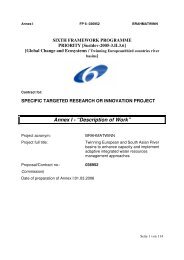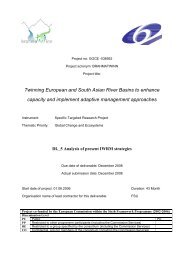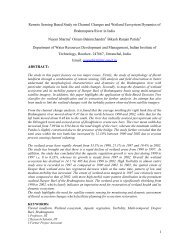4. Lasut 2005 Creative thinking - Brahmatwinn
4. Lasut 2005 Creative thinking - Brahmatwinn
4. Lasut 2005 Creative thinking - Brahmatwinn
You also want an ePaper? Increase the reach of your titles
YUMPU automatically turns print PDFs into web optimized ePapers that Google loves.
1 Introduction<br />
The Network Analysis – <strong>Creative</strong> System Modelling – Decision Support (NetSyMod) methodology<br />
which is being developed in FEEM is intended to become a flexible, but comprehensive<br />
methodological framework and a suite of tools aimed at facilitating the involvement of stakeholders<br />
or experts in various contexts and in particular in those decision making or evaluations processes<br />
characterised by the participation of multiple actors, typically in the field of environmental sciences.<br />
An important component of the NetSyMod methodology is the <strong>Creative</strong> System Modelling (CSM)<br />
phase. This is a key component that makes use of the Actors Identification and Social Network<br />
Analysis outcomes in order to give inputs to the final phase of Analysis of Options.<br />
In this field the international literature is rich, but lacking a reference core of works. There are<br />
several reasons for this, such as the relative novelty of the topic, its development in rather distinct<br />
research fields (psychology, operation research, physics, natural sciences), all producing many<br />
problems in terminology. In the following pages an attempt will be made to provide an overview of<br />
the main relevant concepts and definitions adopted for the NetSyMod developments.<br />
There are numerous examples of dealing with water management problems using participatory<br />
modelling approaches (e.g. Exter, Specht, 2003; Belt, 2004). Incentives for public participation with<br />
respect to solving water problems indicated in the WFD (EC, 2000) result in the research of Group<br />
Decision Support Systems (GDSS). <strong>Creative</strong> System Modelling attempts to formalise and facilitate<br />
the multiple perspectives and knowledge elicitation, which allows structured public participation. In<br />
this paper the difference was made between actors such as: experts and stakeholders with respect to<br />
the preferences elicitation method, due to existing different group dynamics.<br />
2 <strong>Creative</strong> <strong>thinking</strong> and modelling<br />
2.1 Mental models and cognitive mapping<br />
In order to better understand the concept, based on literature studies the relations between reality,<br />
mental model, cognitive map and a scientific model can be visualised as on the following graph<br />
(Figure 1).<br />
Figure 1: A graph relating reality - mental model - cognitive map and a scientific model<br />
Interface:<br />
Individual<br />
Reality<br />
Mental Map/<br />
Model<br />
Interface:<br />
Cognitive Mapping<br />
Techniques Cognitive Maps<br />
Interface:<br />
“Science”<br />
“Model”<br />
Objectiv<br />
e<br />
External<br />
Subjective<br />
Internal<br />
Subjective<br />
External<br />
Pseudo-<br />
objective<br />
2





